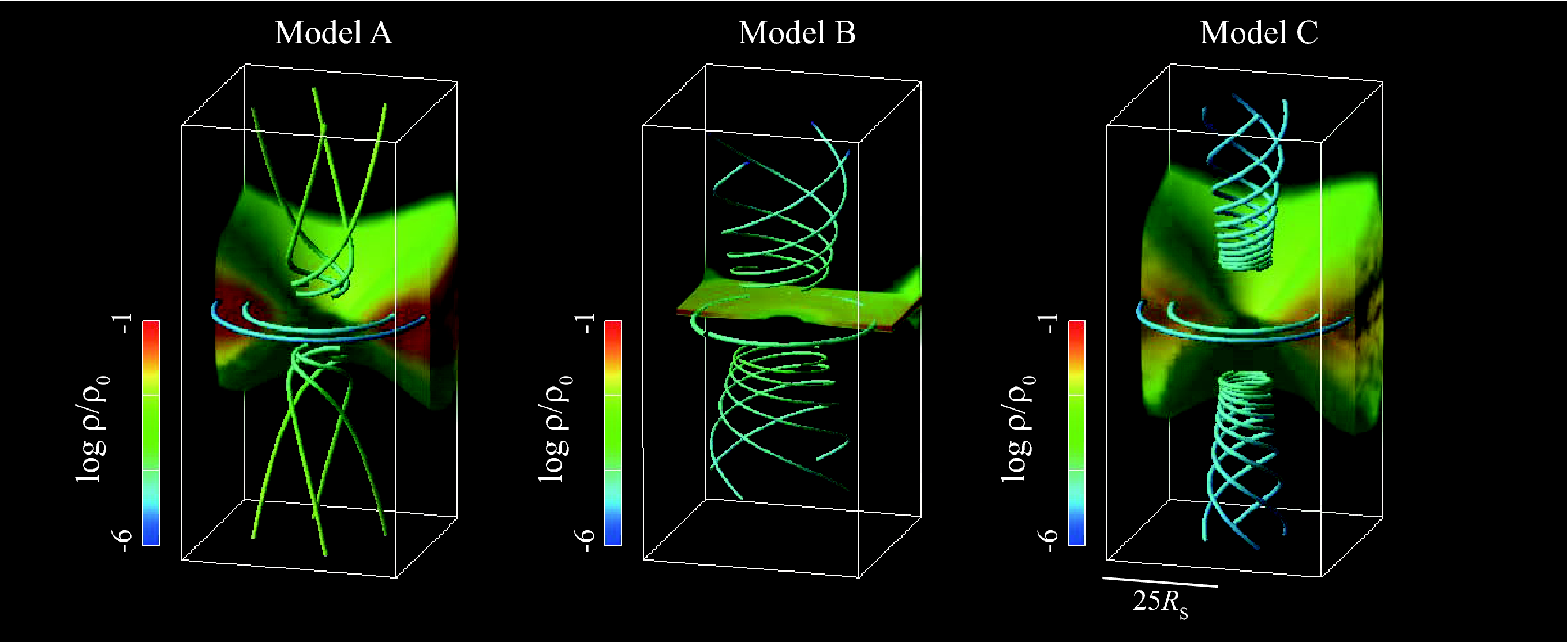Title: Prograde and Retrograde Black Holes: Whose Jet is More Powerful?
Authors: Alexander Tchekhovskoy, Jonathan C. McKinney
Institutions: Princeton, Stanford

Time-averaged flow pattern of material around retrograde (left) and prograde (right) black holes (black dots) spinning at 90% of the maximum possible rotation rate. The black-and-white lines show the magnetic field lines; gray lines indicate the streamlines along which material flows. The color indicates the outflow efficiency in the region, as indicated by the color bar. The green lines show the stagnation surface, where radial inflow stops. The total outflow efficiencies are 34% in the retrograde black hole and 102% in the prograde black hole. From Tchekhovskoy and McKinney (2012).
As cool and crazy as black holes sound, there are only three things you need to know everything about their physics. Age, sex, location? No, try again: it’s mass, rotation, charge. (See the “No-hair” Theorem in this Astrobite.) But how do you measure these fundamental parameters? Since black holes are small, cold and dark, it is basically impossible to observe them directly (much like the person you were just questioning online). However, studying their environments, such as the accretion disks and jets that often surround black holes, can reveal important clues about their nature.
The authors of this paper explore how one of these fundamental properties, rotation, is linked to the powerful jets that emanate from some black holes. Actually, the jets don’t come from inside the black holes, but are rather redirected material from an accretion disk of gas and dust that slowly spirals toward the black hole. The general consensus among the scientific community is that the magnetic fields that interlace the accretion disc are responsible for the redirection of the jets, but the physics of magneto-hydrodynamics is so difficult that no one has come up with a comprehensive analytic solution. Thus, scientists tackle the theory of black holes and their jets with magneto-hydrodynamic simulations (also described in this Astrobite), which has the side effect of producing cool movies (see the links below).
There are two types of rotation for a black hole: a prograde black hole rotates in the same direction as its accretion disk, whereas a retrograde black hole rotates in the opposite direction. The authors ask the question: does prograde or retrograde rotation lead to more powerful, efficient jets? Take a peek at the prograde and retrograde movies to see if you can guess the answer!
What differentiates the authors’ paper from previous research is their emphasis on “thick” disks. Accretion disks can be classified into two types: thin disks, which are so flat they might as well be two-dimensional, and thick disks, which have a thick, wedge-shaped cross-section. The study of thick disks is essential because black holes with strong jets probably have thick accretion disks.
Using general relativity and magneto-hydrodynamics, the authors modeled the evolution of accretion disks around black holes rotating at 90% of their maximum possible rotation rate in the prograde and retrograde directions. To create jets, they set up the initial conditions such that the disk evolved into a Magnetically Arrested Disk (MAD). An MAD has enough magnetic flux at the inner edge of the disk to impede gas inflow and redirect the accreting material into strong, steady jets. This occurs at the thin green line in the figure above. The jet efficiency ![]() is the fractional difference in the black hole’s energy accretion rate due to mass inflow
is the fractional difference in the black hole’s energy accretion rate due to mass inflow ![]() and its total energy accretion rate
and its total energy accretion rate ![]() , or
, or
The authors found that prograde accretion disks produce jets that are about 3 times more efficient than those made by retrograde disks. Their simulations of prograde accretion resulted in efficiencies of 100%, whereas the retrograde simulations had efficiencies of about 34%. This is important because it means that the jet strength can indicate the black hole’s rotation speed and direction. Now if we can just solve for the black hole’s mass and charge, we won’t even have to meet it in person to know everything!




